Duplex stainless steel has austenitic + ferritic duplex organization, both austenitic stainless steel and ferritic stainless steel characteristics. Because of the high strength and stress corrosion resistance, good weldability, superplasticity, low-temperature impact toughness, and other superior properties, duplex stainless steel is widely used in the petrochemical industry. Because duplex stainless steel has both ferrite and austenite two-phase organization, the process requirements for forming and heat treatment are high, and pipe fittings manufacturing is difficult. A detailed analysis of the causes of cracking in the start-up process of duplex stainless steel pipe fittings in a project coal gasification plant, and put forward a number of control measures in the manufacturing process of duplex stainless steel pipe fittings.
In recent years, duplex stainless steel has been more and more widely used because of its high strength, good toughness, and corrosion resistance; the shortcoming is that because it is a two-phase organization of ferrite and austenite, the process requirements for forming and heat treatment are high, adding great difficulty to the manufacturing of fittings, so the quality of duplex stainless steel pipe fittings occurs from time to time. 2015, a gasification unit piping system pressure test, a black water pipeline (material UNS S32750), was found to have water seepage and penetrating cracks in one of the tees. Through the same manufacturer of duplex stainless steel pipe fittings were sampled (destructive) inspection, the results show that a number of technical indicators of fittings need to be qualified.
1. Additional technical requirements of duplex stainless steel pipe fittings for coal gasification plants
Duplex stainless steel pipe fittings in the gasification plant using harsh conditions, in addition to manufacturing standards ASTM A815/A815M, the design also requires to meet the project S32750 super duplex stainless steel pipe fittings technical requirements; additional technical requirements are:
- 1) ASTM A370 impact test at -46 ℃, AKV2 ≥ 70J, allowing a minimum value of not less than 65J;
- 2) Brinell hardness test according to the standard ASTM E10, hardness ≤ 310HB;
- 3) Ferritic and austenitic correspondingly uniform distribution, no precipitation of the third phase. The ferrite content is determined by ASTM E562 point method and should be in the range of 35-60%;
- 4) Corrosion test according to ASTM A923 method C, the specimen should have no signs of corrosion, and the weight loss should be less than 6mdd.
2. Cracked pipe test results
1) The hardness, corrosion resistance, impact absorption, ferrite content (portable ferrite meter), and metallographic organization of some cracked fittings were examined.
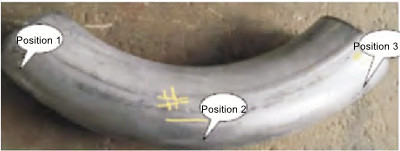
Figure.1 Elbow sampling position
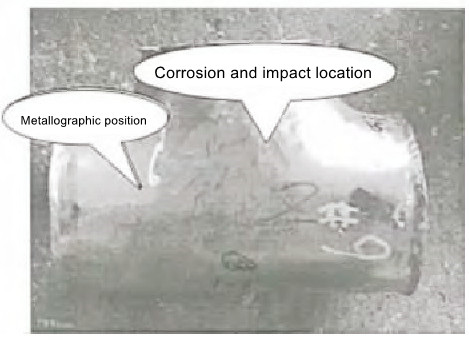
Figure.2 Sampling position of the tee
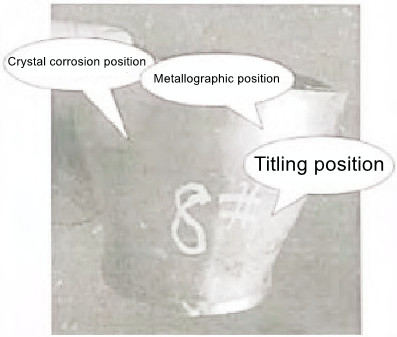
Figure.3 Sampling position of concentric reducer
2) The manufacturer of a number of specifications of the raw material steel pipe field sampling analysis selected different ferritic content of the pipe for impact testing, hardness testing, corrosion testing, and metallurgical organization test; the test results are qualified. As can be seen from Table 1: Figure 4 – Figure 6, the performance indicators need to be qualified.
3. Analysis of the test results
1) Cracked tee impact absorbed work and metallographic organization are not qualified, a metallographic organization in the σ phase, this harmful phase makes the material brittle, σ phase in the use of the process will become the origin of the crack, with the expansion of the crack will lead to cracking of the entire pipe; the rest of the sample pipe fittings are at least one technical indicators do not meet the requirements, some are not qualified impact value, some are not a qualified metallographic organization, some are more than 2 not Qualified. The test results show that these S32750 duplex stainless steel products are not strictly in accordance with the project’s technical requirements for testing that delivery and the manufacturer’s serious lack of quality awareness.
Table.1 Test results of sampled fittings
| Sample No. | AKV2 7.5 x 10 x 55/J | HBW | Corrosion rate/mdd | Metallography | Comprehensive conclusion | |
| Ferrite content,% | Organization | |||||
| No.1 Elbow-1 | 110.6/162.4/9.1 | 275/274/272 | 77.69 | 37 | There is a large amount of σ-phase on the phase boundary between ferrite and austenite, Figure 4. | The overall mechanical properties of the elbow are uneven. The impact value and hardness value are better at one end, but the efficiency decreases quickly at the middle position and the other end; the corrosion rate, impact value and hardness value, and metallographic organization are not qualified. |
| No.1 Elbow-2 | 3.4/3.1/3.6 | 3171315/313 | 225.61 | 18 | ||
| No.1 elbow-3 | 3.2/2.3/3.2 | 373/3731375 | 455.83 | 17 | ||
| No.6 tee | (Sample 10 x 10 x 55}12.0/3.3/5.2 | 293/292/292 | 1.59 | 57 | The σ-phase is distributed on the phase boundary between ferrite and austenite and extends to ferrite Figure 5. | Impact value and metallographic organization are not qualified Corrosion rate and hardness value are qualified. |
| No.8 size | 25.3、36.2、12.2 | 271/269/266 | 1.93 | 53 | Ferrite and austenite Figure 6. | Impact value failed corrosion rate and hardness value, metallurgical group and ferrite content qualified. |
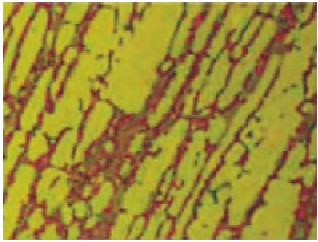
Figure.4 elbow organization
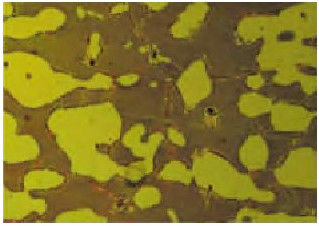
Figure.5 Tee organization
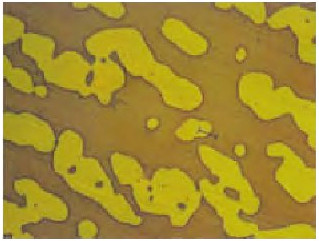
Figure.6 Reducer organization
2) The heat treatment of duplex stainless steel is more sensitive than austenitic stainless steel; there is duplex steel due to the precipitation of harmful phases leading to a decrease in the risk of toughness and corrosion resistance of the metal material. The main reason for the precipitation of the harmful phase is: due to insufficient heat treatment temperature or insufficient holding time; the precipitation of the harmful phase is not completely dissolved, or in the manufacturing process of the material for a long time exposed to the temperature (range) of harmful phase precipitation.
3) The microstructure of duplex steel, namely the phase balance of austenite and ferrite, is an important factor affecting its performance, for the ferrite content in the duplex steel, depending on its chemical composition and thermal cycle history. Duplex stainless steel contains a large amount of ferrite; in the thermal processing process is very easy to produce the σ phase, and this lead to the failure of the final product; heat treatment can also make the ferrite content decreases so that its resistance to SCC, when the ferrite content of less than 30%, there is a risk of SCC, but the ferrite content is greater than 70%, its pitting resistance decreases. Therefore, the development of reasonable forming and heat treatment process, and in the manufacturing process for the special characteristics of duplex stainless steel material to take effective control measures, is the key to ensure product quality.
4) The elbow outside of the high hardness area, which is due to the strong cold deformation of the bend, resulting in high plasticity in the deformation zone residual tensile stress is too high, so that its hardness increases sharply, this area may also occur in the high temperature Cl- environment stress corrosion cracking.
4. Control measures to be taken in the manufacturing process
4.1 Raw material control
- 1) In the procurement of duplex stainless steel pipe, steel plate and other raw materials should be combined with the design requirements and manufacturing process to put forward the material procurement requirements. Raw materials into the plant must be strictly re-inspected, including nondestructive testing and sampling tests, to ensure that the materials used meet the procurement requirements.
- 2) Welded pipe sawed off the pipe blanks, the need for welding seam smoothing treatment, but do not repair excessive grinding.
4.2 Forming control
The forming process should be given priority to the use of the cold forming process. When the need to take hot processing forming, due to duplex stainless steel in 700-950 ℃ will produce σ-phase, so the final forming temperature shall not be less than 950 ℃and requires the cooling rate as fast as possible.
- 1) The forming process must be strictly controlled, equipped, and selected with accurate molds, minimize shaping operations;
- 2) Forming temperature should be strictly controlled;
- 3) Hot forming and hot shaping before the heating should try to use the whole heating method;
- 4) A number of the heated workpiece should not be too much to prevent the temperature of the workpiece from being removed after the forming requirements;
- 5) Hot forming and hot shaping, the workpiece should be immediately water-cooled;
- 6) The workpiece out of the furnace to the forging process should be as short as possible and take appropriate insulation measures to prevent the rapid decline in the temperature of the workpiece; shall not use the direct pounding way to shape.
4.3 Welding control
Do a good job of preparation before welding, including the fusion surface and the joint on both sides of the thorough cleaning, and remove oxidation, rust, grease, paint, color pen marks, and other foreign matter. Acetone, propanol, or isopropyl alcohol can be used on the fusion surface and the adjacent base material to remove grease thoroughly, do not use solutions containing chlorine elements, methanol, and industrial methylated alcohol.
Spot welding should be used GTAW process and argon gas protection. The torch should be as vertical as possible and close to the operating point to avoid mixing air in the shielding gas. The root weld should be removed from the spot weld to prevent cracking of the root weld at the spot weld.
4.4 Heat treatment control
After forming, the product should be solid solution treatment, water quenching, and cooling. Duplex stainless steel pipe fittings should be heat treatment process assessment, assessment of qualified processes before use, in order to prevent improper heat treatment caused by unqualified product performance.
4.5 Inspection and testing of duplex stainless steel pipe fittings
Products must be strictly in accordance with the design requirements for nondestructive testing and sampling tests; the product performance indicators are in line with the design requirements before delivery.
5. Conclusion
Duplex stainless steel pipe fittings due to its austenite and ferrite duplex organization, so that deformation processing difficulties, deformation processing temperature control range is narrow, improper control during the thermal processing is prone to σ-phase or phase disproportion, so the manufacturing of duplex steel pipe fittings should be optimized through the process plan, improve the tooling, manufacturing experience, strict control measures to ensure the reliability of product quality.
Author: Zhao Baoxing
Source: Duplex Stainless Steel Pipe Fittings Manufacturer – Alloyworld Co., Limited (www.alloyworld.cn)

